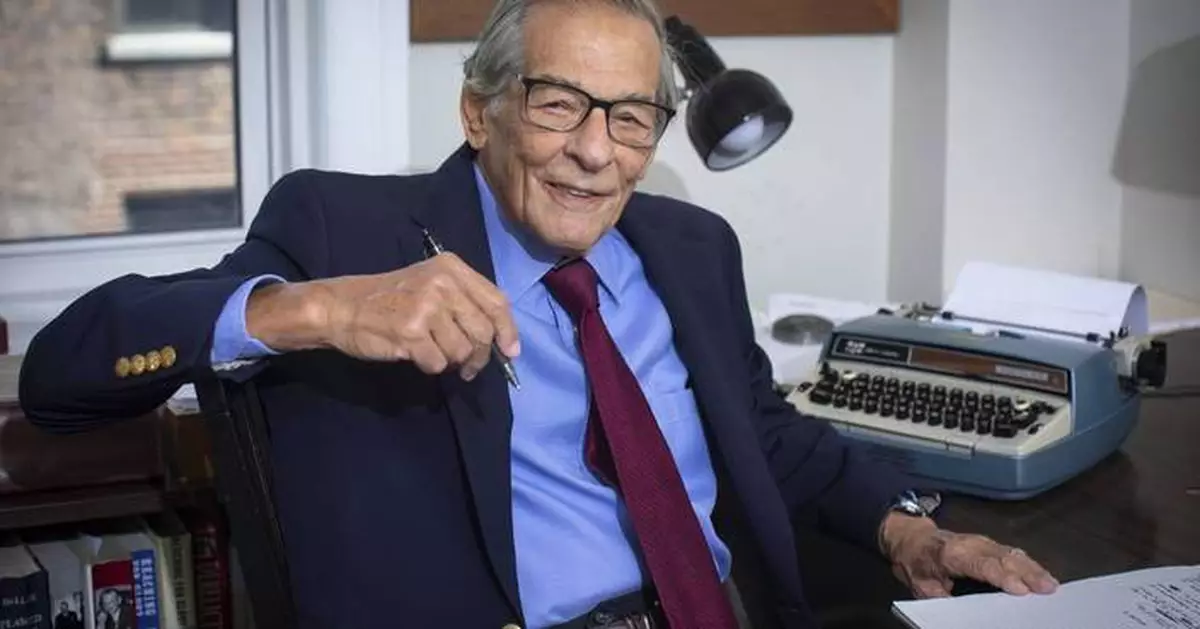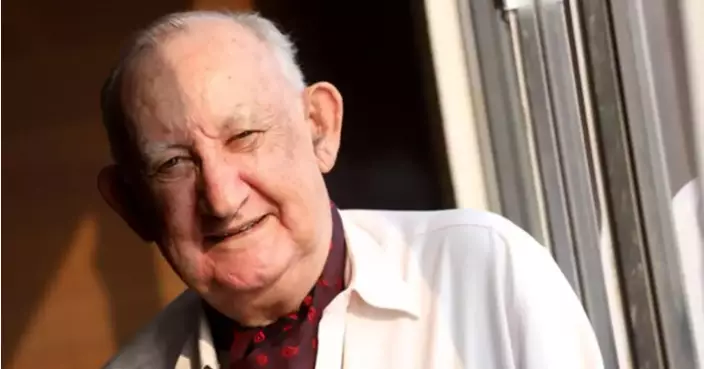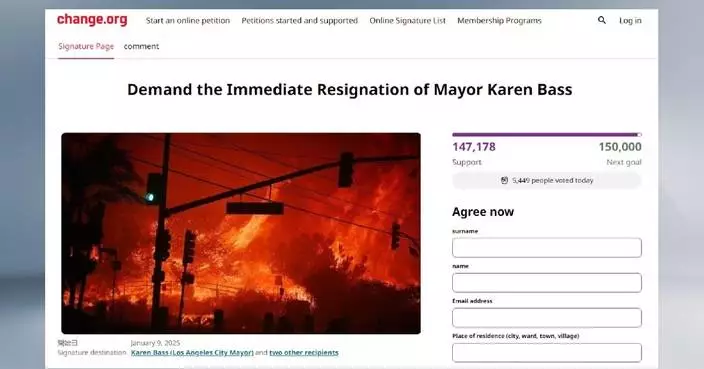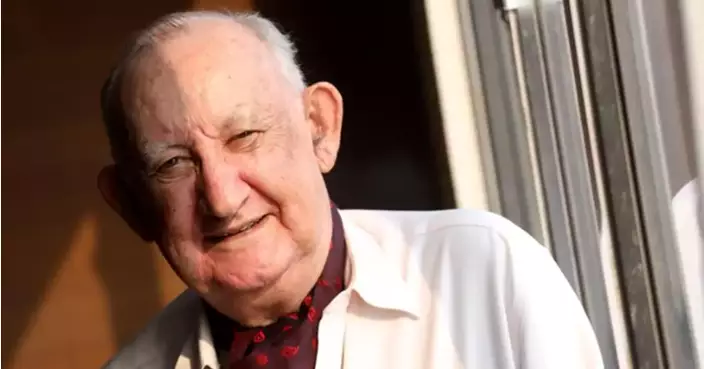NEW YORK (AP) — Robert A. Caro stands between two giant columns in a second-floor library of the New-York Historical Society, looking out on dozens of friends, family members and colleagues. A research room named for him looms behind. Portions of his archives are on display nearby.
“The most honest thing I could possibly say tonight is also possibly the corniest, and that is having my archives here is, in a way, a dream come true,” the historian said during a recent dinner tribute at the Society, a 200-year-old institution located opposite Central Park that he would visit often as a child who already imagined becoming a writer.
Click to Gallery
FILE - Author and biographer Robert Caro stands beside an image of his younger self after touring a permanent exhibit in his honor at the New York Historical Society Museum & Library in New York on Oct. 20, 2021. (AP Photo/John Minchillo, File)
Robert Caro poses for a portrait on Wednesday, Sept. 11, 2024, in New York. (Photo by Andy Kropa/Invision/AP)
Robert Caro poses for a portrait on Wednesday, Sept. 11, 2024, in New York. (Photo by Andy Kropa/Invision/AP)
Robert Caro poses for a portrait on Wednesday, Sept. 11, 2024, in New York. (Photo by Andy Kropa/Invision/AP)
Robert Caro poses for a portrait on Wednesday, Sept. 11, 2024, in New York. (Photo by Andy Kropa/Invision/AP)
Robert Caro poses for a portrait on Wednesday, Sept. 11, 2024, in New York. (Photo by Andy Kropa/Invision/AP)
“I won't say I dreamed of being a well-known writer,” he added. “But my dreams were of being a writer. So now, I am a writer and my papers are here, and you could say it's a dream come true.”
The 88-year-old author spends most of his days writing — the fifth and final volume of his Lyndon Johnson series, more than a decade in the making, is still without a scheduled release date. But in recent weeks, he has been looking back to his first book, to the biography that made him famous, and, for some, infamous: “The Power Broker.” His Pulitzer Prize-winning chronicle of Robert Moses is a page-turning — around 1,300 pages — appraisal of the New York City municipal builder, portrayed by Caro as a man of historic vision and talent whose ego and disregard for others made him a cautionary tale for unchecked authority.
A New Yorker for much his life, Caro is the Society's unofficial laureate, subject of one exhibit — “Turn Every Page” — about his famously thorough research and a new one dedicated to “The Power Broker,” published 50 years ago. “Robert Caro’s The Power Broker at 50” includes typescript pages, notebook entries, letters, press clippings, a draft of the book’s introduction and samples of Caro’s reporting, including a tally sheet that he and his wife, Ina, amassed of commuters to Long Island’s Jones Beach, Moses’ first major public project.
Caro’s book remains widely purchased, taught and discussed, and so much a symbol of serious thought that it turned up in the background of many Zoom interviews with journalists and public figures during the height of the pandemic. The Society not only sells signed copies of his books, but also offers ceramic mugs that read: “I FINISHED THE POWER BROKER."
Although “The Power Broker” is among the longest one-volume books in existence, Caro obsessives — and the author himself — have wondered about the material left out. Caro’s original manuscript was around 1 million words, and some 300,000 had to be removed by Caro and editor Robert Gottlieb just so the book wouldn’t require an extra edition. Missing or drastically cut sections include one on community activist Jane Jacobs, who helped stop Moses’ efforts to build a highway through Greenwich Village, and one on tenants of a Bronx neighborhood uprooted by the Cross Bronx Expressway.
Caro himself has long forgotten what happened to the old manuscript pages, boxed up and placed in filing cabinets decades ago and opened only after the Society acquired his papers in 2020. The exhibit, and his archives, now open to the public, offer few clues.
According to Valerie Paley, senior vice president and director of the society’s Patricia D. Klingenstein Library, virtually all “The Power Broker” papers have been sorted and no sign of a full draft or extensive section of the Jacobs chapter or One Mile sequel has been found. The society's online site dedicated to the archive lists thousands of “Power Broker”-related materials, but nothing specific about Jacobs or the lives of the Bronx tenants after they left.
During a recent interview at his writing office, a short walk from his apartment and the Society, Caro noted one artifact in the exhibit — a napkin on which he had scrawled a few thoughts about “Fiddler on the Roof” and a line about growing up knowing everyone you meet. He had been speaking with some Bronx women displaced by Moses' highway and noted how their fates could be compared to those driven out in Russia by the czar. But what he had hoped would be a long chapter on what happened to them ran just 10 pages.
“I remember writing pages of that chapter over and over again,” he said. ““I thought it was good, but we were coming down to the end and we had to cut another 40,000 words and it had to go.”
“The Power Broker” set the template for Caro's grand ambitions and flexible deadlines. He thought he would spend a few months on the book, but needed more than seven years, taking so long that he and Ina ran out of money and had to sell their home. His background was in journalism; he was a Pulitzer-winning investigative reporter for Newsday. But “The Power Broker” was also influenced by some of the 19th century novelists he admired, notably Anthony Trollope, whom his wife first told him about.
Caro’s narrative has the kind of scale, moral underpinning, political insights and outsized characters — Moses above all — that he admired in such Trollope works as “The Prime Minister.” Asked if “The Power Broker” could almost be called a nonfiction 19th century novel, Caro responded: “Not almost.”
When “The Power Broker” was published, Moses issued a 23-page statement denouncing it as full of “mistakes, unsupported charges” and “random haymakers” and accused Caro of listening too closely to “a few bellyachers on street corners” and “disgruntled truck drivers.” But most critics regarded the book as a revelation and continue to rank it as essential for those interested in politics, urban planning or New York history. Admirers include President Barack Obama, who recalled being “mesmerized” by it when he awarded Caro a National Humanities Medal in 2010.
Even Jacobs forgave him for not mentioning her. In a 1974 letter displayed in the exhibit, she thanked Caro for sending her a copy and expressed gratitude for his efforts.
“I have no doubt that many readers are going to feel the way I do — we owe you a tremendous debt for all those years of hard work, good sense, unflagging curiosity, and compassion,” she wrote. “What an account it is of human predicaments; it ranks with the great novels.”

FILE - Author and biographer Robert Caro stands beside an image of his younger self after touring a permanent exhibit in his honor at the New York Historical Society Museum & Library in New York on Oct. 20, 2021. (AP Photo/John Minchillo, File)
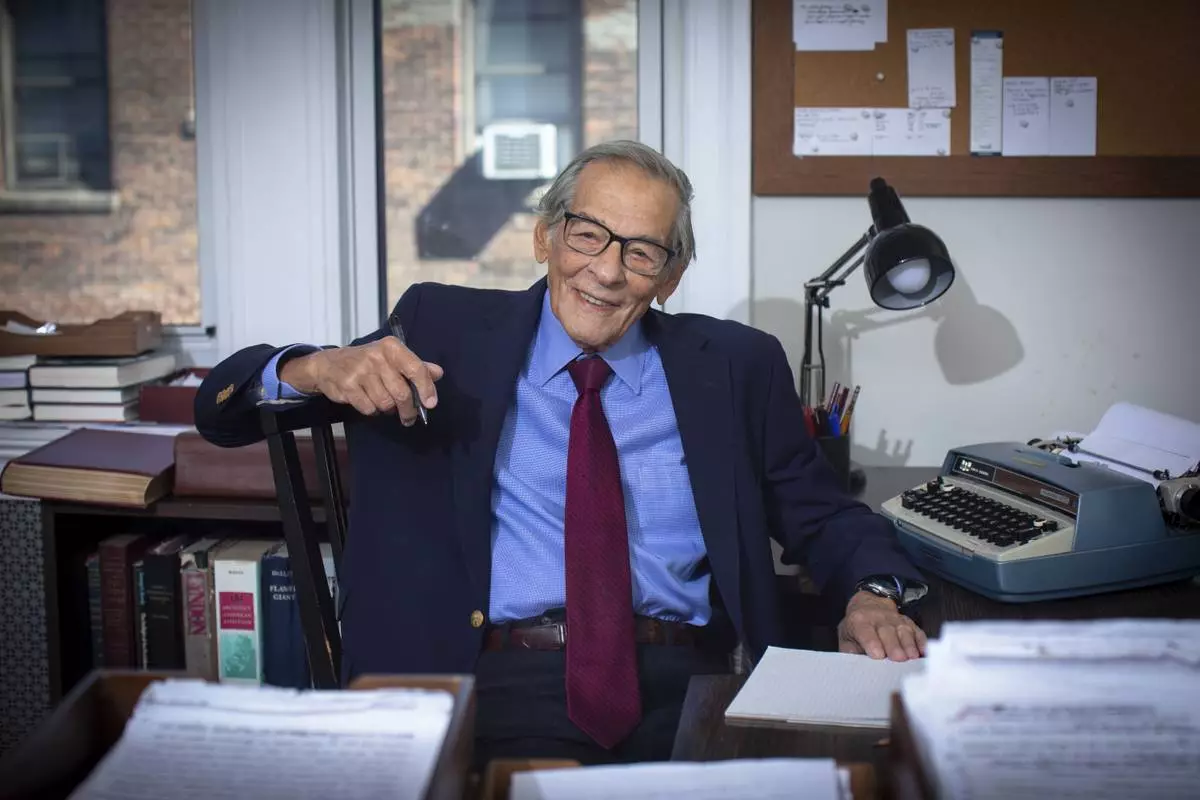
Robert Caro poses for a portrait on Wednesday, Sept. 11, 2024, in New York. (Photo by Andy Kropa/Invision/AP)
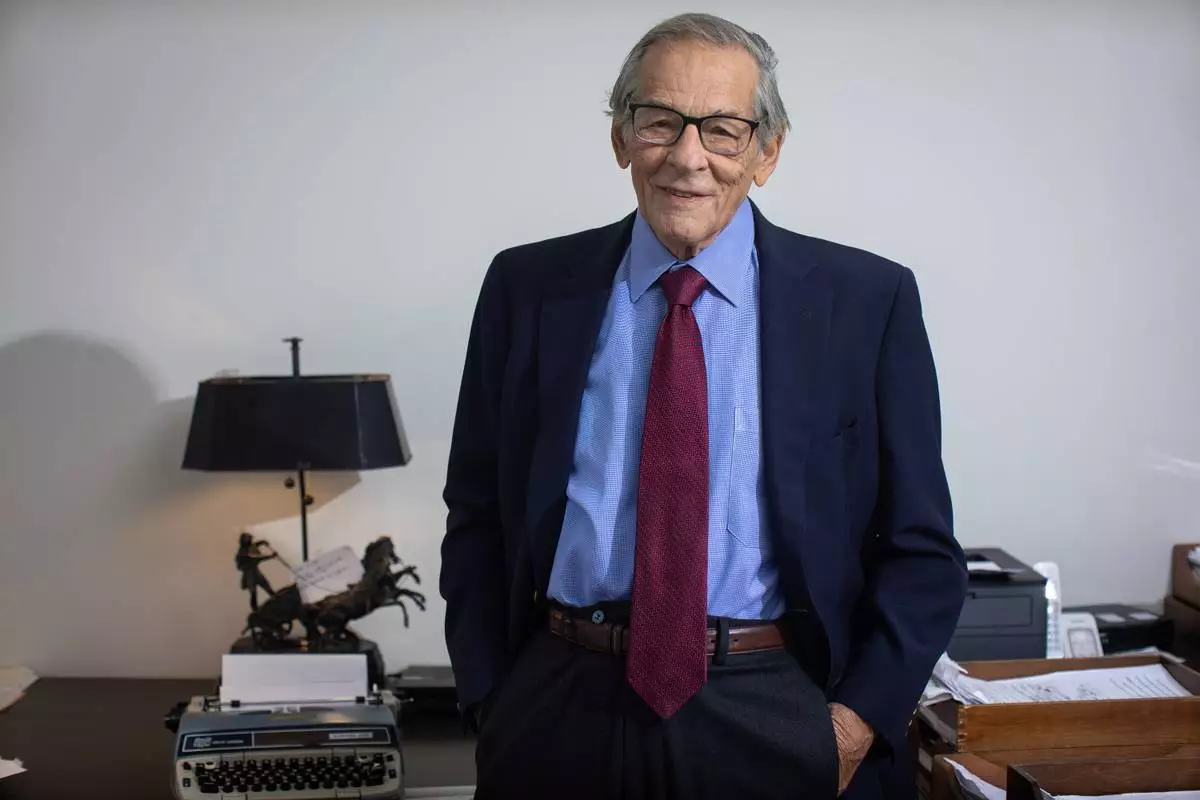
Robert Caro poses for a portrait on Wednesday, Sept. 11, 2024, in New York. (Photo by Andy Kropa/Invision/AP)
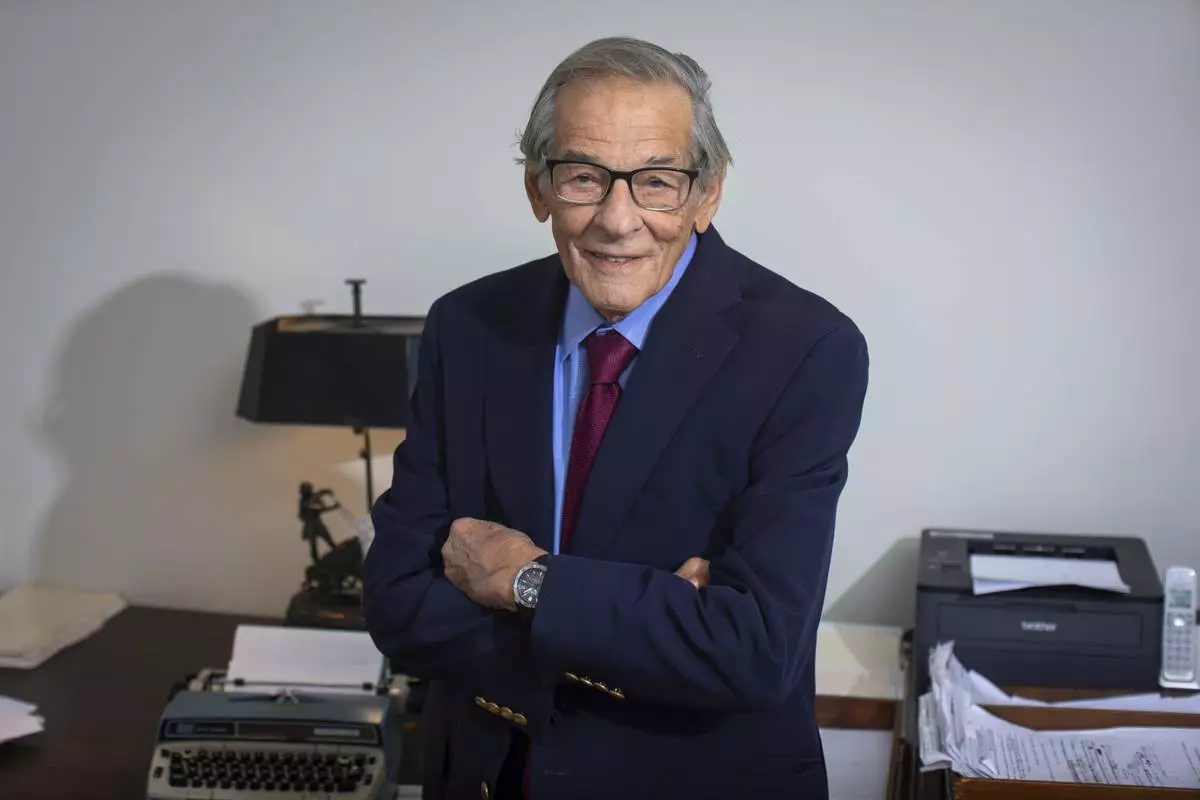
Robert Caro poses for a portrait on Wednesday, Sept. 11, 2024, in New York. (Photo by Andy Kropa/Invision/AP)
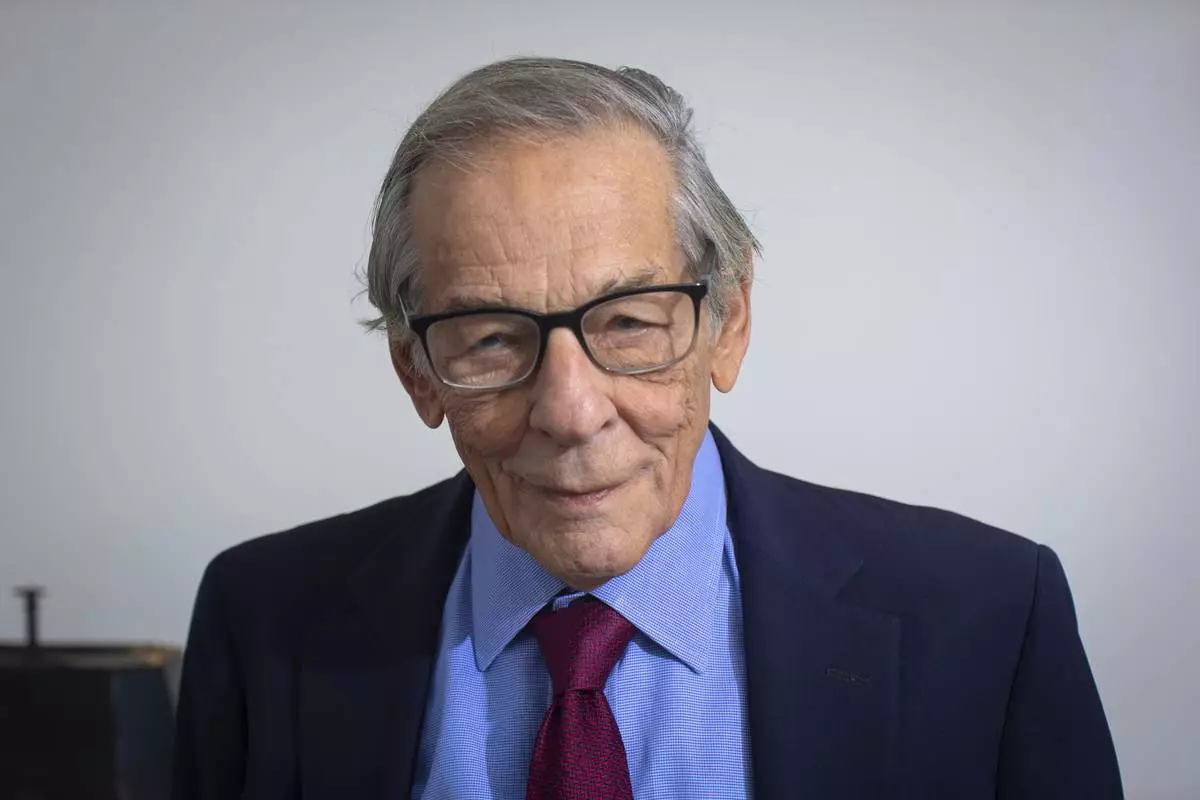
Robert Caro poses for a portrait on Wednesday, Sept. 11, 2024, in New York. (Photo by Andy Kropa/Invision/AP)
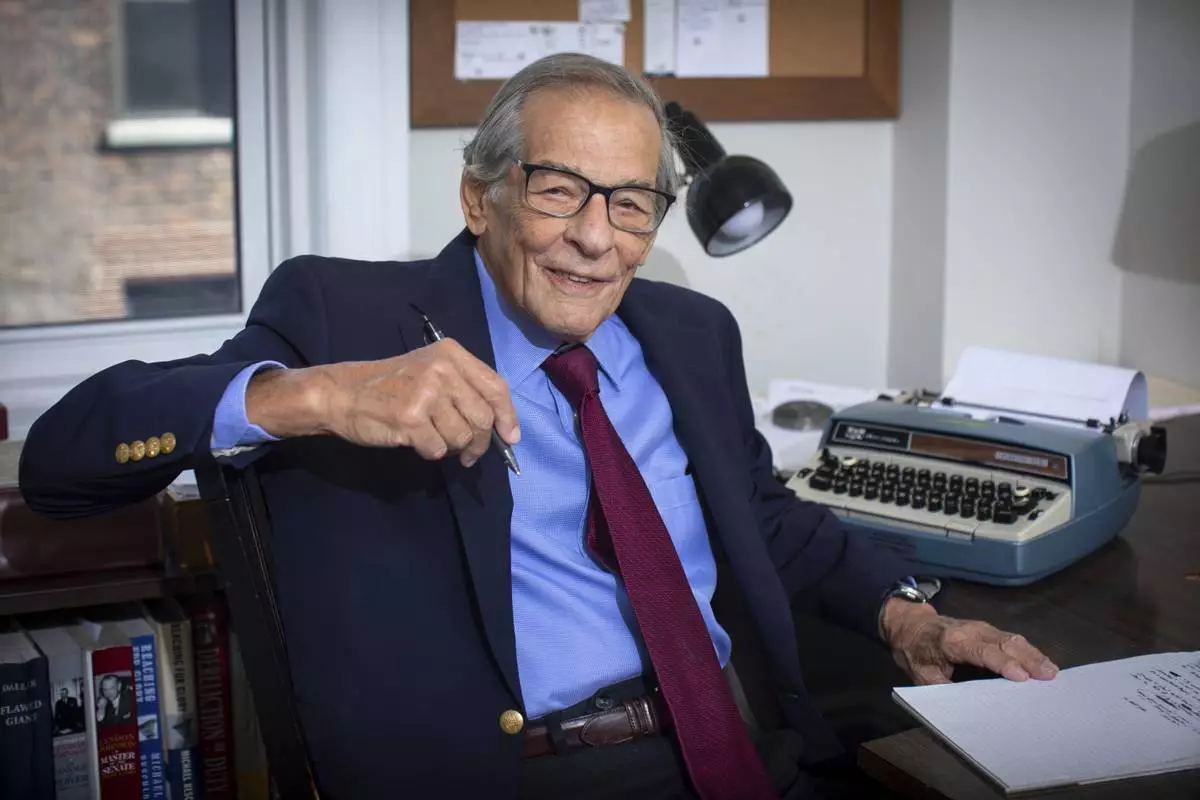
Robert Caro poses for a portrait on Wednesday, Sept. 11, 2024, in New York. (Photo by Andy Kropa/Invision/AP)
LONDON (AP) — A British teen pleaded guilty Monday to murdering three girls and attempting to kill 10 other people in what a prosecutor said was a “meticulously planned” stabbing rampage at a Taylor Swift-themed dance class in England last summer.
Axel Rudakubana, 18, entered the surprise plea as jury selection had been expected to begin at the start of his trial in Liverpool Crown Court.
The July 29 stabbings sent shock waves across the U.K. and led to a week of widespread rioting across parts of England and Northern Ireland after the suspect was falsely identified as an asylum-seeker who had recently arrived in Britain by boat. He was born in Wales.
The attack occurred on the first day of summer vacation when the little girls at the Hart Space, a sanctuary hidden behind a row of houses, were in a class to learn yoga and dance to the songs of Taylor Swift. What was supposed to be a day of joy turned to terror and heartbreak when Rudakubana, armed with a knife, intruded and began stabbing the girls and their teacher in the seaside town of Southport in northwest England.
“This was an unspeakable attack — one which left an enduring mark on our community and the nation for its savagery and senselessness," Deputy Chief Crown Prosecutor Ursula Doyle said. “A day which should have been one of carefree innocence; of children enjoying a dance workshop and making friendship bracelets, became a scene of the darkest horror as Axel Rudakubana carried out his meticulously planned rampage.”
Prosecutors haven’t said what they believe led Rudakubana — who was days shy of his 18th birthday — to commit the atrocities, but Doyle said that it was clear he had a “a sickening and sustained interest in death and violence.”
Rudakubana had consistently refused to speak in court and did so once again when asked to identify himself at the start of the proceedings. But he broke his silence when he was read the 16-count indictment and asked to enter a plea, replying “guilty” to each charge.
He pleaded guilty to three counts of murder, 10 counts of attempted murder and additional charges related to possessing the poison ricin and for having an al-Qaida manual.
Rudakubana faces life imprisonment when sentenced Thursday, Justice Julian Goose said.
Defense lawyer Stanley Reiz said that he would present information to the judge about Rudakubana's mental health that may be relevant to his sentence.
The surviving victims and family members of those killed were absent in court, because they had expected to arrive Tuesday for opening statements.
Goose asked the prosecutor to apologize on his behalf that they weren't present to hear Rudakubana plead guilty.
He pleaded guilty to murdering Alice Da Silva Aguiar, 9, Elsie Dot Stancombe, 7, and Bebe King, 6.
Eight other girls, ranging in age from 7 to 13, were wounded, along with instructor Leanne Lucas and John Hayes, who worked in a business next door and intervened. Fifteen other girls, as young as 5, were at the class but uninjured. Under a court order, none of the surviving girls can be named.
Hayes, who was stabbed and seriously wounded, said he still had flashbacks to the attack and was “hugely upset at the time that I wasn’t able to do more.”
“But I did what I could in the circumstances,” he told Sky News. “I’m grateful to be here, and by all accounts I’ll make a full recovery, at least physically. … I’m going to be OK and others won’t be, and that’s really where I I think the focus of attention should be.”
Police said the stabbings weren’t classified as acts of terrorism because the motive wasn’t known.
Several months after his arrest at the scene of the crime, Rudakubana was charged with additional counts for production of a biological toxin, ricin and possession of information likely to be useful to a person committing or preparing to commit an act of terrorism for having the manual in a document on his computer.
Police said they found the evidence during a search of his family's home in a neighboring village.
The day after the killings — and shortly after a peaceful vigil for the victims — a violent group attacked a mosque near the crime scene and pelted police officers with bricks and bottles and set fire to police vehicles.
Rioting then spread to dozens of other towns over the next week when groups made up mostly of men mobilized by far-right activists on social media clashed with police during violent protests and attacked hotels housing migrants.
More than 1,200 people were arrested for the disorder and hundreds have been jailed for up to nine years in prison.
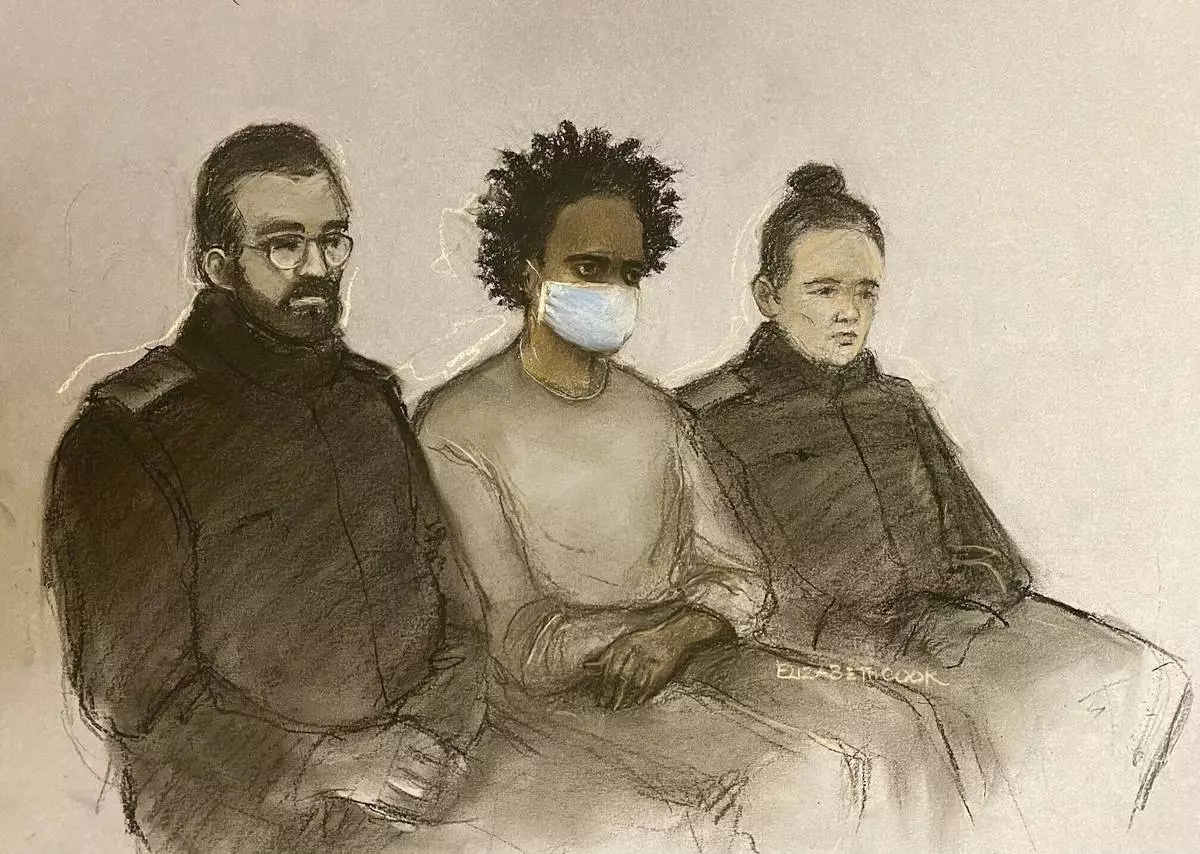
In this Court artist sketch by Elizabeth Cook, Southport stabbings suspect Axel Rudakubana appears on the first day of his trial at Liverpool Crown Court, where he has pleaded guilty to killing three young girls and wounded 10 other people in a knife attack at a Taylor Swift-themed dance class, in Liverpool, England, Monday, Jan. 20, 2025. (Elizabeth Cook/PA via AP)

People queue at Liverpool Crown Court in Liverpool, England, Monday, Jan. 20, 2025 where Axel Rudakubana is charged with killing three girls and wounding 10 other people in a stabbing rampage at a Taylor Swift-themed dance class in England last summer.(AP Photo/Jon Super)

A prison van believed to contain Axel Rudakubana arrives at Liverpool Crown Court in Liverpool, England, Monday, Jan. 20, 2025 where Rudakubana is charged with killing three girls and wounding 10 other people in a stabbing rampage at a Taylor Swift-themed dance class in England last summer.(AP Photo/Jon Super)

A prison van believed to contain Axel Rudakubana arrives at Liverpool Crown Court in Liverpool, England, Monday, Jan. 20, 2025 where Rudakubana is charged with killing three girls and wounding 10 other people in a stabbing rampage at a Taylor Swift-themed dance class in England last summer.(AP Photo/Jon Super)

FILE - Police officers watch members of the public outside the Town Hall in Southport, England, Aug. 5, 2024 after three young girls were killed in a knife attack at a Taylor Swift-themed holiday club the week before. (AP Photo/Darren Staples, File)
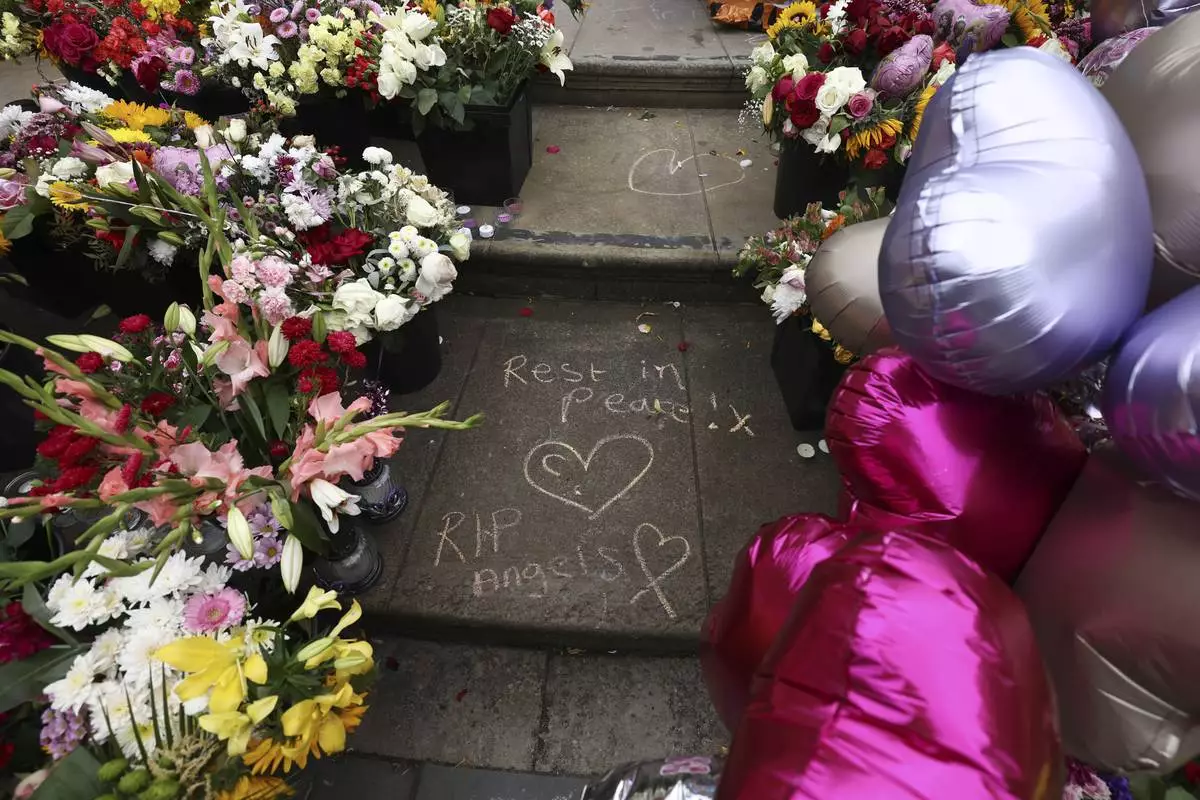
FILE - Tributes are seen outside the Town Hall in Southport, England, Aug. 5, 2024 after three young girls were killed in a knife attack at a Taylor Swift-themed holiday club the week before. (AP Photo/Darren Staples, File)








